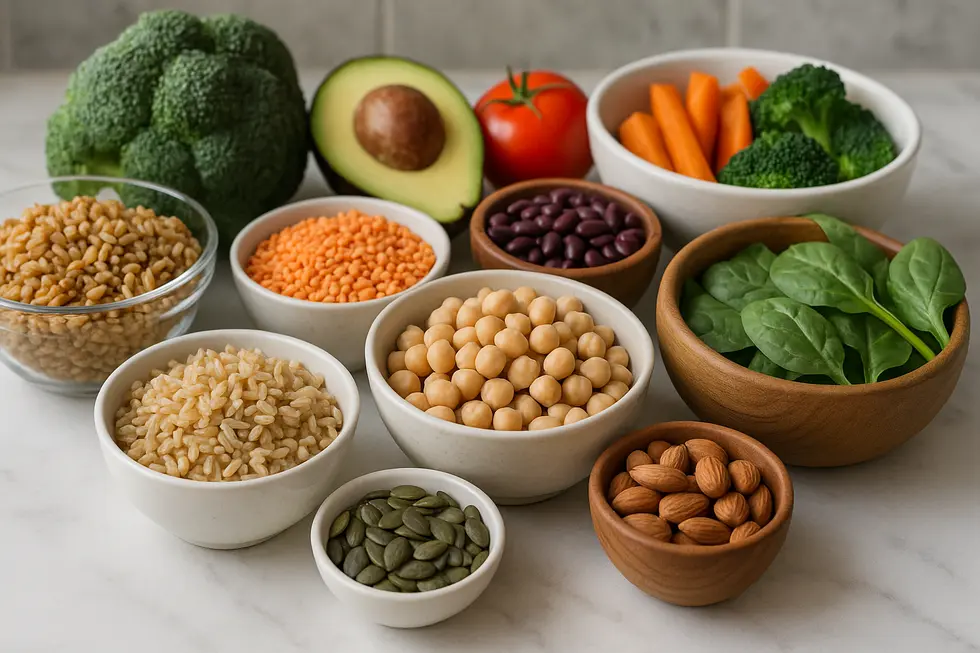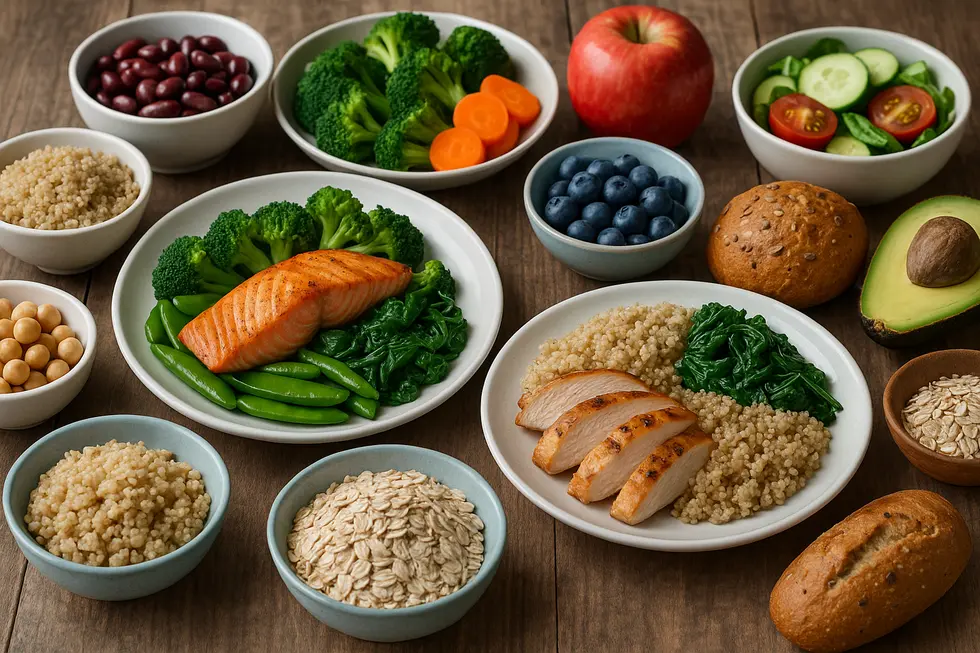Managing blood sugar levels can be a daunting task, especially for those living with diabetes. However, low glycemic meals offer a viable solution by emphasizing foods that digest slowly, thereby preventing rapid spikes in glucose. This comprehensive guide walks you through the nutritional benefits of low glycemic meals, strategies to craft balanced options, and innovative recipes to keep your taste buds delighted. As you read through each chapter, you’ll gain insights into creating meals that not only cater to your health needs but also offer satisfying flavors and textures.
The Nutritional Symphony of Low Glycemic Meals

Creating meals that are not only delicious but also supportive of stable blood sugar levels involves understanding the intricate balance of nutrients present in low glycemic foods. At its core, a low glycemic meal comprises foods that exhibit a slow digestion rate, leading to a gradual increase in blood sugar rather than a rapid spike. This characteristic is quantified by the glycemic index (GI), a ranking that helps us identify such foods. Emphasizing foods with a GI of less than 55 can make a significant difference for individuals managing diabetes or simply aspiring to maintain healthier blood glucose levels.
The nutritional components of a low glycemic meal are strategically chosen to facilitate this slow and steady release of glucose. Key players include fiber-rich foods, protein, and healthy fats. The particular magic of fiber lies in its ability to slow down digestion. Foods like legumes and whole grains are championed for their high fiber content. When we consume a bowl of barley, for instance, the soluble fiber it contains forms a gel-like substance within the stomach, retarding the rate of carbohydrate absorption. The end result is a tempered glucose response that helps stabilize blood sugar levels.
Proteins also play an essential role, offering much-needed sustenance without causing glucose fluctuations. Lean proteins such as poultry and fish are outstanding choices for low glycemic meals. They not only contribute to a feeling of satiety but also work in conjunction with fiber to ensure a balanced digestion process. Just consider the benefits of incorporating a serving of cottage cheese into your snack repertoire. Its high protein and low carbohydrate constitution makes it an exemplary option for maintaining a supportive blood sugar profile.
Healthy fats, found in nuts and seeds, enrich these meals further. They offer a dual advantage: a source of energy that doesn’t overwhelm the body with glucose, and a texture that enhances the meal’s palatability. By including these fats, we ensure that our meals are not just nutrient-dense but also delectable.
Designing meals around low glycemic foods can also be a culinary delight. Whole grains like pumpernickel bread and oatmeal not only serve as hearty breakfast options but also fit seamlessly into a dinner menu by complementing a wealth of vegetables and proteins. The versatility of oats, detailed in our low-glycemic-oatmeal-guide, showcases how variety doesn’t need to be sacrificed even as we aim for nutritional balance.
For producers and consumers alike, reading nutrition labels becomes paramount when selecting low glycemic options. The focus should be on identifying foods with substantial amounts of fiber and protein while steering clear of added sugars and high carbohydrate counts common in processed options. Understanding these labels can empower consumers to make informed choices that align with low glycemic goals.
For further understanding of low GI foods and their impact, Medical News Today offers an in-depth exploration of their nutritional benefits.
In summary, the nutritional symphony composed by low glycemic meals requires a thoughtful curation of ingredients that work in harmony to support health and wellness. By emphasizing fiber, protein, and healthy fats, we craft meals that provide the double benefit of taste and blood sugar balance. As more individuals turn to such dietary strategies, the knowledge of effectively building these meals becomes a crucial ally in promoting long-term health.
Mastering the Art of Balanced Low Glycemic Meals
Crafting balanced low glycemic meals is more than a dietary choice; it’s an investment in long-term health and vitality. By selecting foods with a minimal impact on blood sugar, individuals can manage diabetes more effectively and maintain steady energy levels throughout the day. Central to this strategy is the glycemic index (GI), a metric that evaluates how quickly foods raise blood sugar compared to pure glucose. Foods with a low GI, such as whole grains, non-starchy vegetables, and specific fruits like berries, are the cornerstone of these meals.
A practical tool in creating balanced low glycemic meals is the Diabetes Plate Method. This method provides a visual guide to assembling meals that are both nutritious and well-rounded. It involves dividing your plate into sections: half for non-starchy vegetables, a quarter for lean proteins, and another quarter for whole grains or high-fiber carbs. This structure not only aids in portion control but also ensures a diverse intake of nutrients that collectively support blood sugar management.
When planning meals, selecting foods with a low GI is essential. Focus on ingredients like whole grains, legumes, and non-starchy vegetables including broccoli, cauliflower, and spinach. These foods are inherently rich in fiber, which plays a pivotal role in decelerating the digestion and absorption of carbohydrates. This process is crucial for preventing sharp spikes in blood sugar levels, promoting instead a gradual and sustained energy release.
Incorporating lean proteins into meals is another fundamental strategy. Proteins from sources such as poultry, fish, and legumes are excellent choices. Not only do they help control hunger and satiety, but they also have a minimal impact on blood sugar when compared to carbohydrates. This makes them ideal for people prioritizing blood sugar stability. Moreover, the presence of protein in meals can enhance the overall nutritional profile while supporting muscle maintenance and strength.
Healthy fats also have their place in a balanced low-glycemic meal. Ingredients like avocados, nuts, and olive oil are heralded not just for their role in cardiovascular health, but also for their ability to make meals more satisfying. Healthy fats delay digestion, which in turn aids in maintaining more consistent blood glucose levels. They also provide essential fatty acids that are important for overall wellness.
Integrating flavors into low glycemic meals can elevate the dining experience without compromising health goals. Herbs and spices come into play, offering a spectrum of flavors that can replace sugar and salt. These natural seasonings not only enrich taste but also often provide antioxidant benefits.
For those searching for inspiration, online resources such as the “10 Essential Resources for Crafting a Diabetic Menu” offer invaluable insights. These guides can help people to explore diverse recipes, tips, and ideas that align with low glycemic eating patterns.
Additional creativity can be fueled by experimenting with diverse ingredients and combinations. For instance, using courses that blend sweet and savory elements—like pairing lean protein with a slice of low-GI fruit—ensures a dynamic culinary experience. Options are endless, granted you keep the focus on maintaining the balance among proteins, fiber, and healthy fats.
Finally, maintaining the practice of crafting low glycemic meals is greatly supported by continual learning and adaptation. With the aid of resources like the Glycemic Index Guide (glycemic index guide), you can stay informed about various aspects of glycemic nutrition. This site provides detailed insights into the benefits of different low glycemic foods and how to integrate them effectively into your diet.
By intertwining knowledge with culinary creativity, crafting balanced low-glycemic meals not only becomes a healthful endeavor but also a rewarding and enjoyable lifestyle choice.
Creative Culinary Adventures with Low Glycemic Ingredients

Innovative cooking is not merely about following the latest culinary trends but about finding nourishment that aligns with health and wellness goals. Embracing low glycemic meals invites creativity into the kitchen, encouraging new approaches to classic dishes while maintaining optimal blood sugar levels.
One strikingly innovative recipe is Aubergine Lasagne, where eggplant steps in to replace traditional pasta. This vegetable, when sliced thin and salted, loses its moisture and bitterness, allowing it to transform into layers that support a hearty tomato sauce and cheese. Not only does this swap reduce carbohydrates, but it also enriches the nutritional profile with fiber and antioxidants inherent in eggplants, making it a gluten-free alternative as well.
Another imaginative recipe is the Sesame Tofu & Broccoli Bowl. This meal shines in its balance of proteins and fibers. Tofu, with its excellent protein content, offers a satisfying base when oven-baked to a crisp exterior. Paired with vibrant, nutrient-rich broccoli, the dish satisfies both hunger and health. This bowl, drizzled with a savory-sweet-spicy sauce and topped with sesame seeds and scallions, can be served over cauliflower rice to keep the meal’s glycemic impact low, proving that plant-based eating can be deliciously exciting.
For those exploring plant-based proteins, Vegan Meatballs Made from Chickpeas offer an inventive take. These chickpea meatballs harness the legume’s inherent fiber and protein benefits. By grinding chickpeas with herbs and spices, one can create meatballs that sit comfortably atop whole grain pasta or spiralized vegetables, avoiding high glycemic spikes without sacrificing flavor or satisfaction. These meatballs stand testament to how legumes can redefine classic recipes while meeting dietary restrictions.
Egg rolls are synonymous with indulgence, but when transformed into Egg Roll Bowls Without the Wrapper, they cater to a low-glycemic lifestyle. By focusing on the filling – crunchy fresh vegetables and seasoned ground meat or tofu – one retains the essence of egg rolls without the high-carb wrappers. These bowls offer a low-glycemic punch, rich in flavor, texture, and nutrition.
To further explore innovative low glycemic meal options, one can consider various substitutions like replacing refined grains with whole options such as quinoa or barley while also swapping high-glycemic staples like white rice and potatoes with their lower glycemic counterparts. Using olive oil or avocado for cooking introduces healthy fats that slow digestion and stabilize blood sugar spikes. Meanwhile, combining proteins like tofu or lean meats with fibrous vegetables is an effective strategy to mitigate the meal’s overall glycemic load.
Crafting meals with a low glycemic index is not just an exercise in restraint; it is an invitation to reimagine the culinary possibilities within nutrient-dense ingredients. For a deeper dive into the specific glycemic index values of foods, Glycemic Index provides a reliable resource, while details of various low-glycemic recipes can further enhance one’s culinary repertoire.
By embracing these gastronomic ideas, one can enjoy the richness of flavors while also supporting stable blood glucose levels. For more insights into how these food choices resonate with broader health benefits, visiting the Low Glycemic Foods Benefits might offer additional valuable perspectives.
Final thoughts
Low glycemic meals are a key strategy for maintaining stable blood sugar levels, especially important for those with diabetes. By understanding their nutritional profiles, learning to craft balanced dishes, and experimenting with innovative recipes, you can take control of your dietary needs while still enjoying delicious food. Embrace these approaches to not only support your health but also enrich your culinary experiences.
Don’t just read about better health—live it. Download the Glycemic Index Guide Tracker today to start making smarter food choices, track your glucose, and stay on top of your nutrition—all in one app.
About us
Glycemic Index Guide Tracker is a powerful yet easy-to-use mobile app designed to help you make informed dietary choices by tracking the glycemic index (GI) and glycemic load (GL) of the foods you eat. Whether you’re managing diabetes, following a low-carb or keto diet, or simply aiming to maintain steady energy and better health, the app offers a comprehensive food database, nutrition and glucose tracking tools, weight monitoring, and curated low-GI recipes—all in one intuitive interface. It’s your go-to companion for understanding how different foods affect your blood sugar and for building smarter eating habits.


Leave a Reply